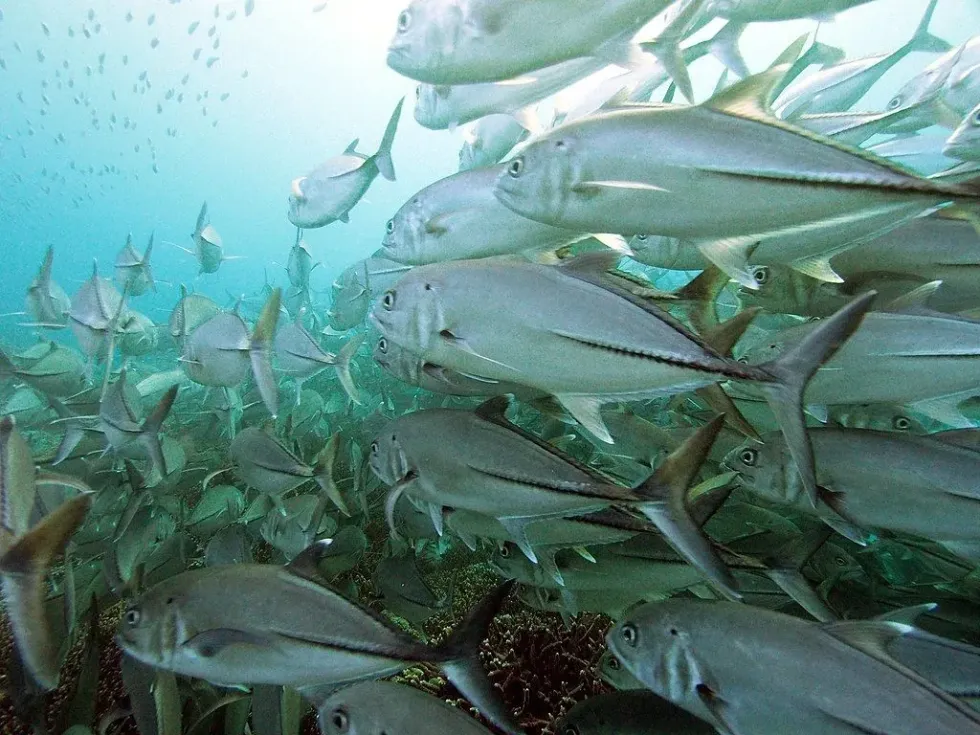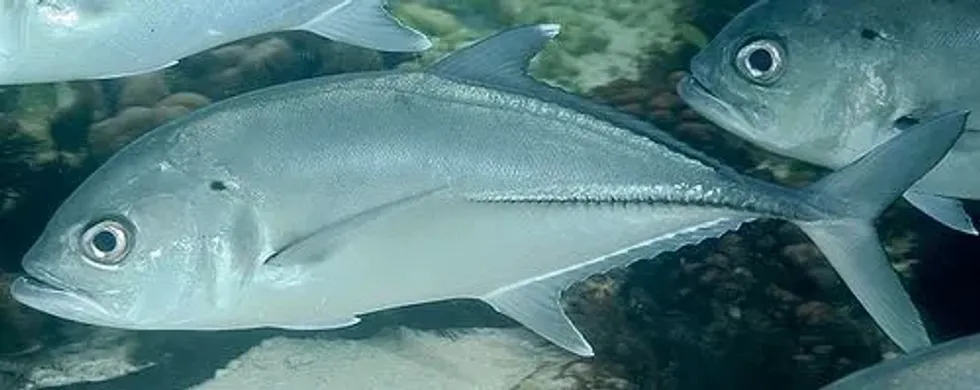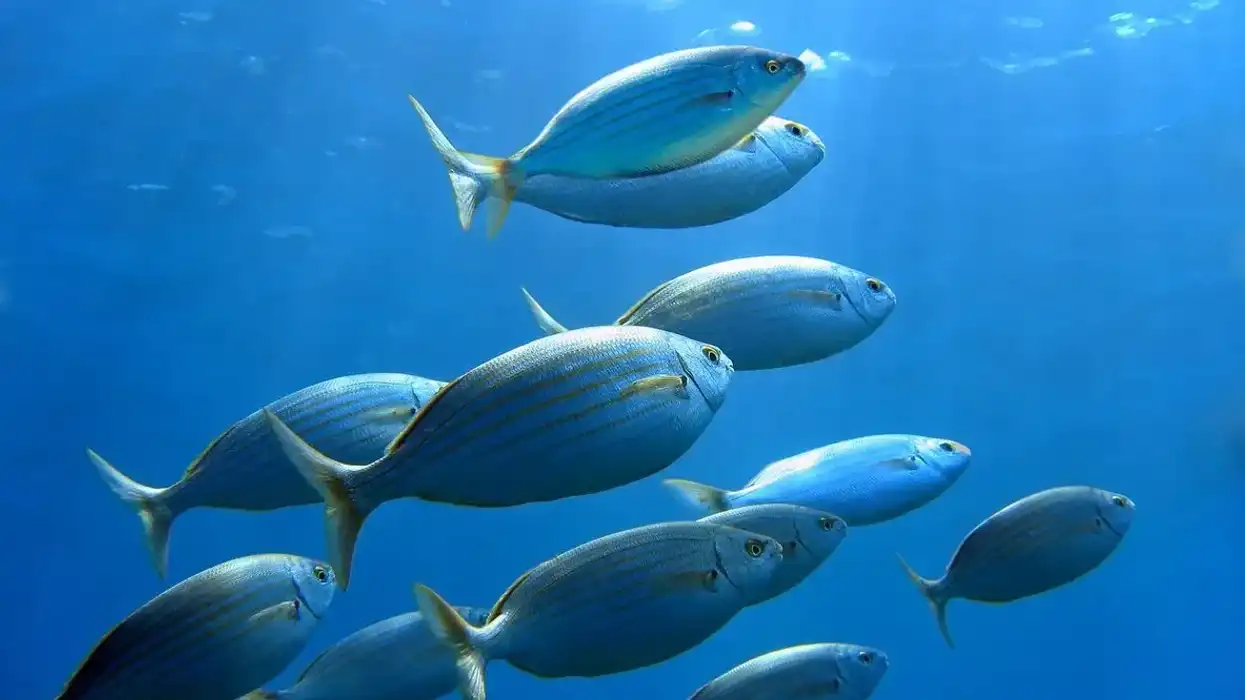Fun Bigeye Trevally Facts For Kids
The bigeye trevally (Caranx sexfasciatus) is a widely distributed large marine fish in the family Carangidae. This large fish distribution is found in the tropical waters of the Indo-Pacific Oceans, specifically in the waters off South Africa in the west, California in the east, and Japan in the north, as well as Australia to the south.
Its characteristics include its dark second dorsal fin with an orange lobe and its dark black spot. The anal fin has two detached spines at its anterior ends.
The fin color varies a lot. This section of the species lateral line has scales anteriorly and strong scutes.
Along with gill rakers, add vertebrae. The breast is covered in scales.
A row of widely spaced canines and a band of villiform teeth surround a row of conical teeth beneath the upper jaw. Furthermore, the species also has other anatomical features that distinguish it from other fishes of Caranx.
As a juvenile, it usually inhabits estuaries and sandy bays, as well as reefs down to depths in coastal zones and offshore islands.
At night, when the bigeye trevally feeds on a variety of fish, crustaceans, cephalopods, and other invertebrates, the school is often found in large groups. It is much active at night-time.
As it matures, the fish switches from a crustacean-dominated diet to a fish-dominated diet. Fisheries throughout its range are moderately important to the bigeye trevally, and artisanal fisheries are considered important.
It is caught using gill nets, purse seines, hooks, and other artisanal fishing methods. In addition to being good gamefishes, the species is also easily caught with lures, baits, and spears.
If you like reading about the bigeye trevally, you might also like the zebra shark and the megamouth shark.
Bigeye Trevally Interesting Facts
What type of animal is a bigeye trevally?
The bigeye trevally (Caranx sexfasciatus) is a marine fish of the Carangidae family.
What class of animal does the bigeye trevally belong to?
The bigeye trevally (Caranx sexfasciatus) is a type of fish of genus Caranx.
How many bigeye trevallys are there in the world?
The exact estimate of the population range is not known, but their number seems to be in wide range for it to be in the Least Concern.
Where does the bigeye trevally live?
Its distribution is wide in both in the Indian and Pacific Oceans, in the tropical and subtropical waters. From the Red Sea and the Persian Gulf, it reaches as far west as Madagascar and South Africa to California.
Several offshore Indian Ocean islands extend their range east along with India, Southeast Asia, and Indonesia. This Indo-Pacific region stretches from Japan to Australia.
Bigeye trevallies inhabit most tropical island groups in the Pacific Ocean, including Hawaii, whose range extends east to the western coast of North America. Throughout this eastern part of its range, it has been found south of the Galapagos Islands but north of California, including the Gulf of California.
What is a bigeye trevally habitat?
Generally, the bigeye trevally (Caranx sexfasciatus) inhabits shallow coastal water habitat, but it's also found offshore, near remote islands, and around seamounts. Around 100 meters of depth are known to be reached by this species.
Adults are mostly found over coral and rocky reefs, but in small numbers, it also inhabits sand bays and lakes. On offshore islands or deep seamounts, inhabitants often live.
Some species follow the tides in some regions, moving into the shallows at high tide and retreating to the deeper reefs at low tide.
A juvenile fish tends to inhabit shallower areas around the coast, usually in lagoons, mangrove zones, and tidal flats. Rivers in several locations have been reported to harbor juvenile bigeye trevally, which usually makes it as far upstream as possible.
A growing fish moves into deeper waters over reefs. In open ocean settings, the species has been observed milling around buoys, indicating it may follow flotsam to a great distance.
Who does the bigeye trevally live with?
Bigeye trevally (Caranx sexfasciatus) is known to form schools of over 1500 fish. During the day, these large schools can often be seen either stationary or slowly moving around the reef complexes they inhabit.
How long does a bigeye trevally live?
It has a life expectancy of about 24 years.
How do they reproduce?
Both males and females reach sexual maturity at the same age and at a similar length to the bigeye trevally. Across the range of this species, spawning occurs in the eastern Pacific between July and September, while in South Africa, it occurs between November and March.
A dark new moon may also trigger spawning.
Before spawning, fish aggregate in large schools, with pairs splitting off to begin spawning. The fish under the pair rapidly change color to a dark black just before they leave the school, while this individual chases off any other marine fish that approaches the pair.
Once spawning has ended, the trevally usually swims horizontally for a few seconds before reverting to their normal color and returning to the school. Anal fin ray count of 15 - 17 is the lowest among east Pacific carangid larvae, a feature that is distinct from other east Pacific carangid larvae.
There is limited research on the late stages of growth.
A large number of juveniles have also been found living in estuaries and pelagic habitats around floating objects. In some cases, juveniles have also been found in South African estuaries where they had spawned.
What is their conservation status?
The bigeye trevally (Caranx sexfasciatus) has been listed as the Least Concern under the IUCN Red List.
Bigeye Trevally Fun Facts
What does the bigeye trevally look like?
Bigeye trevally (Caranx sexfasciatus) is one of the largest members of Caranx. Like most other jacks, it has a compressed, oblong body, with a convex dorsal profile and a concave ventral profile, especially anteriorly.
Snouts are rounded and longer than eyes, and they are slightly pointed. In total, the dorsal fin has two segments.
The first consists of eight spines, while the second involves one spine and between 19 - 22 soft rays. The anal fin has 2 anteriorly detached spines and 14 - 17 soft rays.
The pelvic fin has a spine and 17 - 18 soft rays, the caudal fin is strongly forked, and the pectoral fins falcate. This section of the species lateral line has 49 - 50 scales anteriorly, while the straight section has no scales and 27 - 36 strong scutes.
Scales cover the entire breast. In the upper jaw, this species has an outer row of widely spaced canine teeth and an inner band of villiform teeth, and a row of conical teeth at the bottom of the jaw.
It also has well-developed adipose eyelids. In addition to having 21-25 gill rakers, the bigeye trevally has 25 vertebrae: the body patterns and overall color of the bigeye trevally change with age. Initially, juveniles were light yellow to silvery brown in color.
They mature into silvery blue and whitish, and the bands fade and become indistinct. The dorsal color of adults is silvery olive to blue-green, fading to silvery white below.
The fins of juveniles are paler grey or yellow, with dark edges. In adulthood, they are mostly black, with a dark second dorsal fin and anal fins.
Two dorsal fins have a distinctive white tip. Also, the bigeye trevally has a small dark spot on its upper margin of its body.
The lateral line is moderately arched anteriorly. The fin color varies a lot in real life.

How cute are they?
Owing to their large size and length in real life, bigeye trevally species look intimidating and scary and cannot be considered cute.
How do they communicate?
Marine fish generally communicate by various silent mechanisms like gesture and motion. Travellies are known to communicate in the same way.
How big is the bigeye trevally?
The Caranx sexfasciatus (bigeye trevally) size is 47.2 in (120 cm).
How fast can bigeye trevally swim?
Large silvery predators glide along the water with a speed of more than 31.1 mph (50 kph).
How much does a bigeye trevally weigh?
The bigeye trevally is 39.7 lb (18 kg) in weight.
What are the male and female names of the species?
There is no specific name given to separate sexes of bigeye trevally, they are simply referred to as the female bigeye trevally and the male bigeye trevally. It is also known as the bigeye jack, great trevally, six-banded trevally, and dusky jack.
What would you call a baby bigeye trevally?
A baby bigeye trevally is called a fry.
What do they eat?
When dusk falls, this species becomes active and feeds on food for several hours through the night. Despite primarily eating small fish, it also consumes a variety of invertebrates as food. Cladopods, copepods, stomatopods, jellyfish, sponges, and open ocean species of sea-skater insects are some of these crustaceans.
Are they dangerous?
Bigeye trevally species aren't typically dangerous to humans, but they should be kept in mind when venturing out to reefs. As these large game fish can inflict pain or hurt you, it is not advisable to feed them.
This species is easily caught with lures, gill nets, baits, and spears. It can also be caught using gill nets, purse seines, hooks, and other artisanal fishing methods.
Would they make a good pet?
It is not recommended to keep these large fish as pets. The size and length of these species make domesticating them extremely difficult.
Did you know...
A large bigeye trevally species is regarded as an excellent gamefish by anglers of all skill levels. When the fish are hungry around jetties and wharves, boat fishermen often catch this species, but when it's dark, and the schools are hugging the sea walls, it's frantic activity.
Some specimens are taken from beaches occasionally but rarely in large quantities. It is common to use both bait fishing and lure fishing to catch fish, which includes using live or dead bits of fish, squid, or crustaceans.
Bigeye trevally has been known to accept a variety of lure types, including jigged metal slugs as well as bibbed lures.
The species has been known to take plastic lures, as well as saltwater fly patterns. A robust, well-maintained gear must be used to land large fish.
Bigeye jack line class and tippet records are maintained by the IGFA. Fish captured off Seychelles' Poivre Island weighed 31.5 lb (14.3 kg).
One of the sharks from tropical waters was originally considered bigeye trevally but lack of relatively dark spots, lighter-colored scutes on the body, and had smaller eyes than expected. It was confirmed to be a hybrid specimen.
Can you eat bigeye trevally?
Bigeye trevally is said to be edible as food in some countries in Southeast Asia. It can be fried, steamed, grilled, or even added to soups.
According to the Filipinos, fish taken from Lake Taal have a delicate flavor due to their sulfur content and are considered to be of high quality. Markets sell the species fresh, dried, and salted.
Types of trevally?
There are at least 23 species of trevally found on the East coast of Australia. They form large schools. Some are namely, giant trevally, silver trevally, gold spotted trevally, banded trevally, blue trevally, thicklip trevally, bluefin trevally, bigeye trevally, golden trevally, sand trevally, and diamond trevally. Freshwater crayfish and freshwater fish leather jacket lings are some other examples.
Here at Kidadl, we have carefully created lots of interesting family-friendly animal facts for everyone to discover! For more relatable content, check out these reef shark facts and hammerhead shark facts.
You can even occupy yourself at home by coloring in one of our free printable bigeye trevally coloring pages.
Main image by zsispeo and second image by Christo.j.brown.
We Want Your Photos!
More for You
See All
Bachelor of Arts specializing in Linguistics

Martha MartinsBachelor of Arts specializing in Linguistics
Martha is a full-time creative writer, content strategist, and aspiring screenwriter who communicates complex thoughts and ideas effectively. She has completed her Bachelor's in Linguistics from Nasarawa State University. As an enthusiast of public relations and communication, Martha is well-prepared to substantially impact your organization as your next content writer and strategist. Her dedication to her craft and commitment to delivering high-quality work enables her to create compelling content that resonates with audiences.
Disclaimer
1) Kidadl is independent and to make our service free to you the reader we are supported by advertising. We hope you love our recommendations for products and services! What we suggest is selected independently by the Kidadl team. If you purchase using the Buy Now button we may earn a small commission. This does not influence our choices. Prices are correct and items are available at the time the article was published but we cannot guarantee that on the time of reading. Please note that Kidadl is a participant in the Amazon Services LLC Associates Program, an affiliate advertising program designed to provide a means for sites to earn advertising fees by advertising and linking to Amazon. We also link to other websites, but are not responsible for their content.
2) At Kidadl, we strive to recommend the very best activities and events. We will always aim to give you accurate information at the date of publication - however, information does change, so it’s important you do your own research, double-check and make the decision that is right for your family. We recognise that not all activities and ideas are appropriate for all children and families or in all circumstances. Our recommended activities are based on age but these are a guide. We recommend that these ideas are used as inspiration, that ideas are undertaken with appropriate adult supervision, and that each adult uses their own discretion and knowledge of their children to consider the safety and suitability. Kidadl cannot accept liability for the execution of these ideas, and parental supervision is advised at all times, as safety is paramount. Anyone using the information provided by Kidadl does so at their own risk and we can not accept liability if things go wrong.
3) Because we are an educational resource, we have quotes and facts about a range of historical and modern figures. We do not endorse the actions of or rhetoric of all the people included in these collections, but we think they are important for growing minds to learn about under the guidance of parents or guardians.







